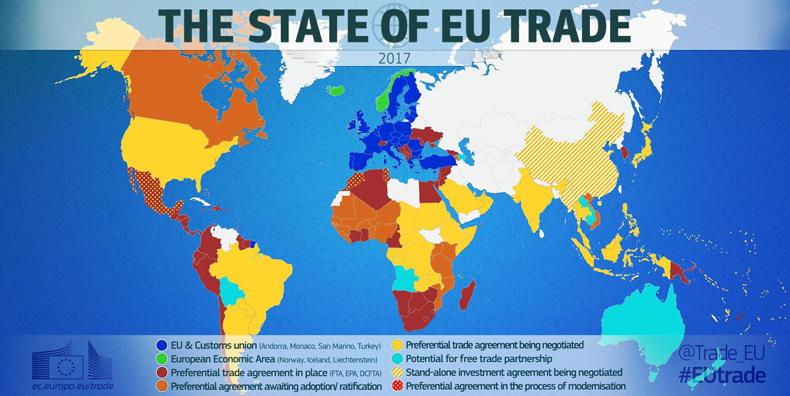Farmers wrestling with weather and bad market prices may wonder what the EU is doing in relation to global trade deals and negotiations has got to do with them. The short answer is an awful lot.
This week, DG Trade published its second annual report on the implementation of free trade agreements (FTAs) that the EU is participating in.
The accompanying map is a graphic summary of the global reach of agreements or negotiations that are in place.

Basically, there is engagement with over 100 countries, including all the major economic powerhouses, with only Russia and a handful of smaller countries outside the loop.
Different types of FTA
There are different types of agreement that are already in place, as well as a series of negotiations that are ongoing.
The most integrated of course is the European Union itself, comprised of 28 countries at present, reducing to 27 after the UK leaves in March 2019.
Next to membership, the closest arrangement is membership of the European Economic Area (EEA), which applies to Norway, Iceland and Lichtenstein. This is basically being part of the single market, but excluding being part of a customs union.
Switzerland unique
Switzerland isn’t formally a member of the EEA, but has many of the same characteristics through a series of bilateral treaties delivering a similar outcome to EEA membership.
They are members of the European Free Trade Association (EFTA), as are the EEA members.
Turkey is not part of either of these, but has a customs union with the EU. This means that Turkey cannot independently enter third-country trade deals, but is bound by trade deals entered into by the EU.
Partnerships
Moving further out, there is a series of what are described as first-generation free trade deals, which are essentially confined to tariffs alone. These involve Middle Eastern, African and Central American countries.
Many of these didn’t include agriculture at the outset, with it often being added later, if at all. One of these, with Mexico, was updated in 2018.
These also include Stabilisation and Association Agreements (SAAs), with the Balkan countries of Albania, Kosovo, Montenegro and Serbia.
The EU has also a series of Economic Partnership Agreements (EPAs) with 29 African, Caribbean and Pacific countries.
These are all developing economies and the arrangement is that the EU will allow them duty-free and quota-free trade to EU markets, while they, in turn, commit to moving to liberalising their market access for 80% of their imports over a 15- to 20-year period.
Recent FTAs
New-generation FTAs are more comprehensive and go beyond tariff-free trade. They extend to services and public procurement, with the most recent including South Korea and Canada.
These are what is described as deep and comprehensive free trade agreements on the basis that they go well beyond the basics of a FTA.
The deal finalised with Japan also goes into this category and it is one that is particularly favourable for farmers, given that they are among the top importers in the world of agri produce.
A final category of agreement is the deep and comprehensive free trade area, which is seen as a forerunner to full EU membership. Georgia, Moldova and the Ukraine are currently in this category of relationship with the EU.
Negotiations
As well as signing deals with Vietnam and Singapore recently, the EU is currently in negotiations with the group of South American countries that are part of Mercosur, Australia and New Zealand.
All of these pose threats to Irish and EU farmers because they are all huge exporters of agri food produce.
One deal that remains to be sorted is with the departing UK.
This will be unlike any other, because it is the first time that a deal is negotiated with a country that was previously a member.
It is the outcome of this that will impact on farmers either side of the Irish border the most of all.






 This is a subscriber-only article
This is a subscriber-only article











SHARING OPTIONS: